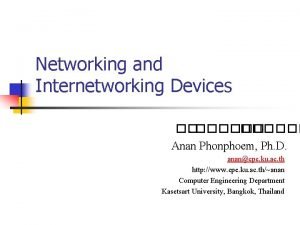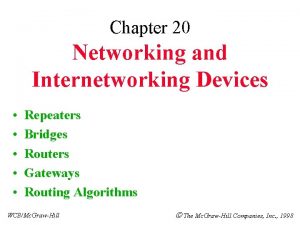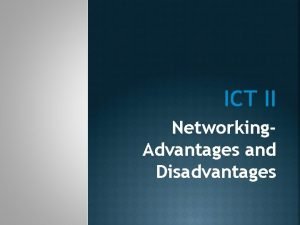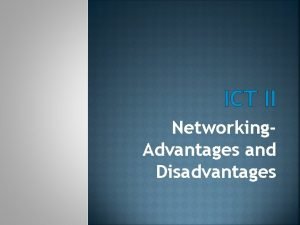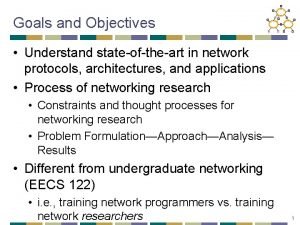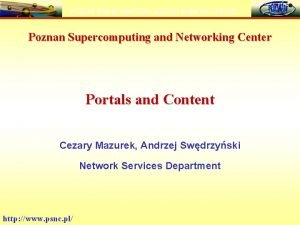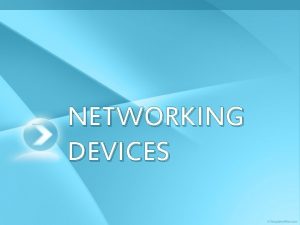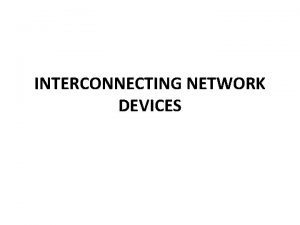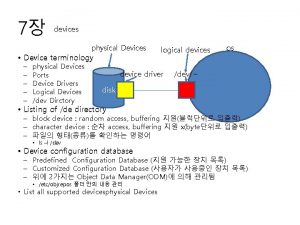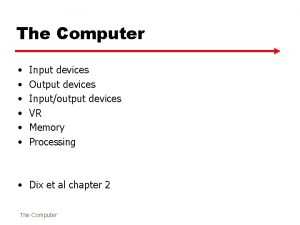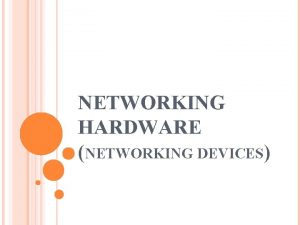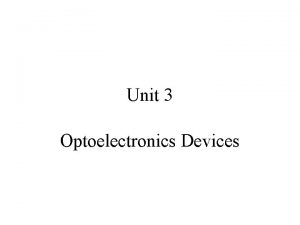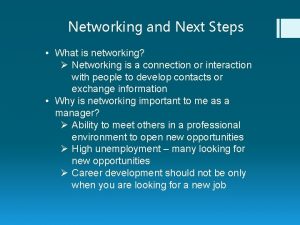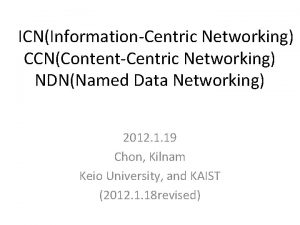Unit 2 Networking LO 2 Networking devices and
























- Slides: 24

Unit 2 - Networking LO 2 Networking devices and operations

Networking devices: Servers Tower Servers Like traditional PC’s. A standalone machine that is built into an upright case. Mostly in smaller datacenters. Can be noisy and take up more physical than alternatives Rack Servers Mounted within a rack. Uniform width and servers are mounted to the rack using screws. Can accommodate multiple servers and the servers are typically stacked on top of each other.

Networking devices: Servers Blade Servers Have standard size and mount inside a special “rack” known as a chassis. Tend to be vendor proprietary. E. g. HP and Dell components will not work together. Blade servers lack power supplies and other components Accept various modular components such as a power supplies, storage units or the server.

Networking devices: Hubs Send data packets to all devices connected to the hub, regardless of whether the data package is destined for the device. Inefficient because of this, performance bottlenecks can occur when busy. Use twisted-pair cabling to connect devices. Hubs also can be joined to create larger networks. Does not perform any processing on the data it forwards, nor does it perform any error checking. Switch’s are more advanced and have generally replaced HUB’s

Networking devices: Switches; Multilayer switch Switches Like hubs, switches are the connectivity points of an Ethernet network. Devices connect to switches via twisted-pair cabling, one cable for each device. The difference between hubs and switches is in how the devices deal with the data they receive. Forwards data to only the port that connects to the destination device in contrast to a Hub. It does this by learning the MAC address of the devices attached to it and then by matching the destination MAC address in the data it receives. Greatly reduces traffic and collisions in contrast to a Hub. Remember Collisions occur on Ethernet networks when two devices attempt to transmit at exactly the same time. A basic switch works at: OSI Layer 2 (the data link layer) A multilayer switch works at: Layer 2 and/or OSI Layer 3 (the network layer). Multilayer device can operate as both a switch and a router.

Networking devices: Routers A router derives its name from the fact that it can route data it receives from one network to another. In a common configuration, routers create larger networks by joining two network segments. A small office, home office (SOHO) router connects a user to the Internet. A SOHO router typically serves 1 to 10 users on the system. A router works at Layer 3 (the network layer) of the OSI model. Normally routers work and forward data based on IP addresses

Networking devices: Firewall & HIDS Firewall Either hardware- or software-based, that controls access to your organization’s network. Protect data and resources from an outside threat. Typically placed at a network’s entry/exit points E. g between an internal network and the Internet. After it is in place, a firewall can control access into and out of that point. Another example could be internal however such as between sales and accounts departments. Many broadband routers and wireless access points have firewall functionality built in. Often require minimal initial configuration but can be customized to restrict access on specific ports and IP addresses. Host-Based Intrusion Detection System (HIDS): Refers to applications such as spyware or virus applications that are installed on individual network systems. The HIDS monitors and creates logs on the local system.

Networking devices: Repeaters; bridges Repeaters Receives a digital signal and sends the signal along the next leg of the network. A series of repeaters make possible the extension of a signal over a distance. Repeaters remove the unwanted noise in an incoming signal. Bridges Connect and divide network segments Manage the flow of traffic between network segments Works at the data link layer (OSI model layer 2) Most bridges have only 2 or 4 ports. A switch can have hundreds of ports. Looks at the destination of the packet before forwarding unlike a hub A switch is more efficient in today's large networks

Networking devices: wireless devices; access point Wireless devices Such as tablets, phones, laptops, PC’s and most modern technology Using standard IEEE 802. 11 they connect to each other or a Wireless Access Point Wireless Access point Wireless APs are used to create a wireless LAN and to extend a wired network. APs are used in the infrastructure wireless topology. APs also typically have several ports, giving you a way to expand the network to support additional clients.

Networking devices: Content filter, Load balancer. Content filter Any software that controls what a user is allowed to peruse and is most often associated with websites. E. g using a content filter, an employer can block access to pornographic sites to all users, some users, or even just an individual user. Load This is usual configured within your server firewall balancer A technique in which the workload is distributed between several servers. This feature can take networks to the next level; it increases network performance, reliability, and availability. This can be configured in the “Network load balancer manager” within Windows Server

Networking devices: repeaters; bridges; VPN concentrator Modem Short for modulator/demodulator. Converts the digital signals generated by a computer into analog signals that can travel over conventional phone lines. Can be an internal add-in expansion cards or integrated with the motherboard, external devices Packet shaper Bandwidth management technique or device Used to prioritise certain traffic over others VPN concentrator Increases remote-access security Can create the tunnel and also authenticate users, encrypt the data, regulate the data transfer, and control traffic.

Networking software: Client operating system, Client software Operating system Manages hardware and software resources and provides common services for computer programs. Can be linked to a Networking/Server OS which allows for user login and services access. Include: Microsoft Windows, Linux(Such as Ubuntu, Red. Hat, Fedora), Mac OS Client software Software that resides on a network users PC. Could be distributed from the server Includes: MS Office, Internet Explorer or any that are installed on the OS

Networking software: Server operating system, Server software Server operating system Open source, Proprietary, General purpose, Task specific SOS/NOS include: Windows Mac. OS Server Apache Linux(e. g Ubuntu Server, Red. Hat, SUSE, Cent. OS, Debian, Oracle, Clear. OS, Solaris, Free. BSD) Server software Antivirus – Symantec Endpoint Protection, Mc. Afee Endpoint Security Backup Software – e. g Acronis Backup and Restore, Symantec Backup Exec Roles, services and applications can be installed within Windows Server

Server type: Web, file, database, combination, virtualisation, terminal services server. By installing and configuring roles within your server operating system you can change the type of server and what it can do: Web: Server configured to store, process and deliver web pages to clients. File: Allows resources to be shared between clients on the network. System admin can regulate who has access to what. Database: Hosts a database which is accessible and modifiable by the clients. Useful for booking or ordering systems. Combination: Provides multiple services or roles. Virtualisation: Meaning one physical server that potentially is split into many virtual servers and/or even clients Terminal services: Allows for taking remote control of clients on the network.

Server selection: Cost, purpose, operating system requirement. When choosing a server consider the number of clients it will be serving and the type of infrastructure it will be working with. Consider what type of role the server will be doing. Blade or rack servers for instance are not necessary in a small home or him business because of cost reasons. Linux maybe preferable for cost reasons. But are the server admins familiar with the with it?

Workstation: Hardware - Network Card Network card Enables systems to connect to the network Can be add-in expansion cards or built-in interfaces. Data is given to it by the CPU and then sends it to a destination. Translates the data into a form that can be transferred via cables and then translates the data it receives back into data usable by the computer Ethernet port on the motherboard indicates network card is built in

Workstation: Hardware Cabling Category Speed 1 1 Mbps 2 4 Mbps 3 16 Mbps 4 20 Mbps 5 Unshielded Twisted Pair (UTP) Cable Least expensive and most commonly used Copper cable that consists of 2 to 1800 unshielded twisted pairs surrounded by an outer jacket. Can experience electrical frequency interference Quality of cable is graded by category's 5 e 6 7 Shielded Twisted Pair (STP) Cable STP cable is the same as UTP but has shielding to electrical frequency interference. Three different types are available: Each pair of wires is individually shielded with foil. Foil or braid shield inside the jacket covering all wires (as a group). There is a shield around each individual pair, as well as around the entire group of wires (referred to as double shield twisted pair). 100 Mbps (2 pair) 1000 Mbps (4 pair) 1, 000 Mbps 100, 00 Mbps Use Voice Only (Telephone Wire) Local. Talk & Telephone (Rarely used) 10 Base. T Ethernet Token Ring (Rarely used) 100 Base. T Ethernet Gigabit Ethernet

Attenuation Workstation: Hardware - Cabling Coaxial Cable Found success in both TV signal transmission and network implementations. Inexpensive and easy to use Prone to cable breaks, which increase the difficulty when installing and troubleshooting coaxial-based networks. The weakening of data signals as they travel through a medium. Network media vary in their resistance to attenuation. Coaxial cable generally is more resistant than UTP; STP is slightly more resistant than UTP; and fiber-optic cable does not suffer from attenuation. Fiber Optic Cable Addresses the shortcomings of copper-based media. Because fiber-based media use light transmissions instead of electronic pulses Cable Max Distances Does not suffer from attenuation Most expensive but provides higher speeds and longer distances UTP/STP: 100 m Coaxial: Up to 500 m Fibre: 60 miles

Workstation: Hardware - Permissions Policy management: Through group policy management network admins can restrict user access and service access control within workstations. Service access policies: Examples include e-mail, file, web and printing. Who needs access to what? Policy's should ensure that only users who need services have access to them User access policies: Who has access to the network? Users should have username and passwords setup and only access to data essential to their role.

Workstation: Hardware - System bus Connects the major components of a computer system. Control bus Used for the CPU to communicate throughout the system. Deals with determining what the data does Communicated to components and through cables to I/O devices Contains instructions for writing(Sending) and receiving Address bus Deals with where data should go Data bus Carries data

Workstation: Local-system architecture Motherboard Holds and allows communication between many of the crucial electronic components of a system. Such as CPU, RAM, Storage along with connections to I/O devices Processor The CPU is responsible for executing a sequence of stored instructions called a program. A CPU has four primary functions: Fetch: Retrieves the instruction that it needs to run from program memory. Decode: Breaks the code down to Machine code. Execute: Calculate extremely complicated mathematical functions and move data from one memory location to another. Write back: Takes the output and writes it into the computer’s memory

Workstation: Local-system architecture Memory Random Access Memory (RAM), is generally what hardware experts mean when they talk about memory. Not Hard Drives, Flash Drives or Cache. It’s volatile memory that stores information on an integrated circuit used by the operating system, software, and hardware. Much faster than storage Storage Non volatile memory sometimes known as secondary memory. Such as: Blu-Ray – Single Layer(25 GB) & Dual layer(50 GB). Speed up to 72 MB with 16 x Drive. Hard Drive – Storage commercially available up to 16 Terabytes. Speed of 80 -160 MB/s. SSD – Storage commercially available up to 2 TB. Speeds up to around 712 MB/s

Volatile Primary Memory Non. Volatile Storage Non. Volatile

Workstation: Local-system architecture e. g. memory, processor, I/O devices. Input devices such as: Controllers Keyboards Mouse Scanners Output devices such as: Monitors Speakers Printers
 Sdn and traditional networking
Sdn and traditional networking Networking and internetworking devices
Networking and internetworking devices Networking and internetworking devices
Networking and internetworking devices Example of literary element
Example of literary element Input device
Input device Unit 6 review questions
Unit 6 review questions Homework 3 modern materials answers
Homework 3 modern materials answers Unit 2 energy, materials, systems and devices answers
Unit 2 energy, materials, systems and devices answers Txv equalizer line
Txv equalizer line Backbone network components
Backbone network components Business data communications and networking
Business data communications and networking Disadvantages of social network
Disadvantages of social network Persuation and networking
Persuation and networking Disadvantages of networking
Disadvantages of networking Ictii
Ictii Computer networks assignment
Computer networks assignment Jalinan dan jaringan (networking and linkages)
Jalinan dan jaringan (networking and linkages) Pengertian kolaborasi jaringan
Pengertian kolaborasi jaringan Goals of network layer
Goals of network layer Analogue and digital transmission in computer networks
Analogue and digital transmission in computer networks Transmission basics and networking media
Transmission basics and networking media Introduction to data communications and networking
Introduction to data communications and networking Poznan supercomputing and networking center
Poznan supercomputing and networking center Networking and internetworking
Networking and internetworking Hamming distance in computer network
Hamming distance in computer network

